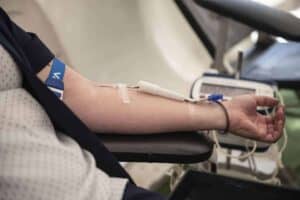While manicures might feel like self-care, gels and acrylics can ruin healthy, natural nails – and might cause unexpected health problems.

From Kylie Jenner and Rihanna to Ariana Grande and Cardi B, celebrities are sporting long, acrylics – often heavily embellished with nail art – as an expression of their style.
Nail fashion is a booming industry with gel manicures and acrylic nails among the most popular current trends.
While manicures might feel like self-care, they can ruin healthy, natural nails. It might even cause unexpected health problems in a small proportion of people who get them.
Nail glue for acrylics often contains a mix of alcohol, cyanoacrylate, photo-bonded methacrylate, and formaldehyde, a known carcinogen.
The chemicals in the nail adhesives can cause skin irritation and dermatitis.
Nail glue burns are also widely reported. In some cases, nail glue spilt on clothing has caused injury by burning through the fabric and damaging the skin beneath, which can then become infected.
Prolonged wearing of gels and acrylics can also lead to pseudo-psoriatic nails, where extra skin – known as hyperkeratosis – growing under the nail resembles the red and crusty appearance of psoriasis. Many manicure enthusiasts with pseudo-psoriatic nails test positive for allergy to methyl methacrylate.
In some cases, the allergy can be so severe that it causes the permanent loss of fingernails. Others suffer from peripheral neuropathy – tingling or numbness in fingers – sometimes permanently.
An unlikely cause of skin cancer?
There are many factors that contribute to cancer risk, including age, skin type, previous exposure and family history; however, there are cases of skin cancer where UV nail lamps are reported to have played a role.
Gel nails are cured using special dryers that emit ultraviolet light in the form of UVA, which hardens the gel converting it to stiff polymers. Since most people have their nails done every few weeks – and it takes approximately ten minutes to harden – that significantly increases UVA exposure.
The back of the hands may be one of the most UV-resistant parts of the body. It’s also unprotected by clothing. It’s also one of the most common places people forget to apply sun cream. If sunscreen is applied to hands, then it’s often washed off regularly without being reapplied.
If you’re a fan of gels, reduce your risk of UV exposure by applying a high-factor sunscreen 30 minutes before the appointment. Also, wear dark, fingerless gloves during the manicure.
Removal of gels and acrylics can cause weak nails
Removal of gels and acrylics often peels or shaves away fragments of the nail plate. Even the most painstaking removal can damage the nail’s keratin layers. This can weaken the nail, and cause it to become brittle. The damage can make nails appear white (a condition known as pseudoleukonychia).
Many of the chemicals used for removal such as acetone, can also dry out the nail and surrounding skin. It can also be absorbed into the bloodstream.
The removal process for both gel and acrylic manicures can wear down natural nails. They can be overfilled, causing stripes running across the ends of the nails. It can also cause changes and damage to the capillaries underneath.
Removing the nails can also cause traumatic onycholysis. This causes the nail to be pulled away from the bed underneath, giving it a classic rollercoaster appearance at the joint between the nail and the underlying bed. This can open up the barrier that protects the internal body, particularly at the edges on either side of the nail. When they become infected this is known as paronychia.
Leaving false nails on for too long can cause moisture build up underneath, creating an ideal environment for fungal growth.
Often, the changes to the appearance of the natural nail caused by a fungal infection are hidden by the nail product. Hence, infections can progress without being noticed.
Bacterial breeding ground
Even traditional nail varnish isn’t without risk. It can alter pulse oximeter readings, which measure how much oxygen your blood is carrying.
Gels, acrylics and varnish are banned in clinical settings as the spaces under nails and chips on polish are a breeding ground for bacteria. This can be passed between staff and patients.
If you enjoy manicures prioritise caring for your natural nails and avoid gels and acrylics. This helps you notice changes that may indicate health issues, such as fungal infections or even heart problems.
Author: Adam Taylor, Professor and Director of the Clinical Anatomy Learning Centre, Lancaster University.
This article was initially published in The Conversation.






